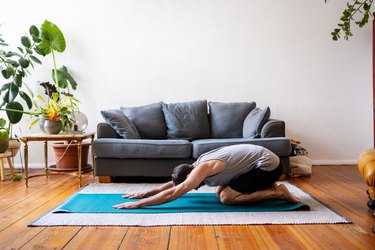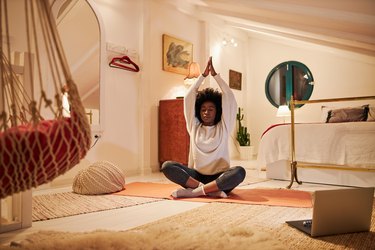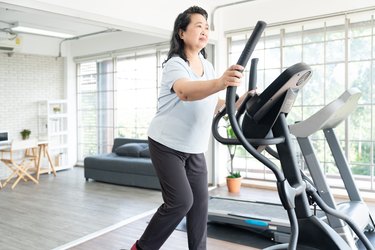

Living with lupus — an autoimmune disease that causes inflammation — can make it difficult to get quality sleep at night due to symptoms such as pain and swelling in the joints. Fortunately, doing some stretches before bed can help ease some of the joint and muscle soreness.
"Reducing and managing stress is an extremely important component of managing lupus and keeping symptom flare-ups at a minimum. Implementing a gentle stretching routine mixed with breathing exercises can really help right before bed," Dallas Reynolds, PT, DPT, physical therapist, certified orthopedic manual therapist and senior director of access management operations at ATI Physical Therapy, tells LIVESTRONG.com.
Video of the Day
In fact, a small September 2018 study in Complementary Therapies in Medicine found that doing yoga helped ease some of the pain and stiffness associated with lupus. The same study revealed that doing yoga helped reduce anxiety and fatigue from lupus — and a big component of treating lupus is to lower stress levels to help prevent flare-ups.
But before diving into a new stretching routine, it's important to consider positions that allow you to feel more comfortable and don't put additional stress on affected joints.
"You will want to incorporate stretches that you can do in relaxed, low-load positions, like sitting or lying down, and to be sure that you are not creating additional stress on any of your joints," Reynolds says.
Pairing gentle stretches with breathing exercises helps activate your parasympathetic nervous system — the part of your nervous system that controls rest and digestion — by lowering your heart rate, Reynolds explains. This ultimately helps prepare your body and mind for sleep.
Here, Reynolds breaks down five gentle stretches for lupus you can do before going to bed (you can even do them in bed) so you can get a good night's rest. Hold each stretch for at least 30 seconds on each side for a total of 2 to 2:30 minutes of stretching per exercise.
Warning
Be mindful of joint pain or swelling in specific areas of your body and avoid those areas until the swelling and pain subsides. Never stretch into pain; stretch just to the point of feeling light tension on the muscle group being stretched, Reynolds cautions.
1. Overhead Reach Stretch
This overhead stretch helps open up your entire upper body and promotes deep breathing by opening up your lungs, Reynolds says.
- Sit upright on a chair, stacking your head over your shoulders and shoulders over your hips.
- Reach your arms straight out in front of you and interlock your fingers.
- Raise your arms overhead until your biceps are by your ears. You should feel a stretch in your shoulders.
- Pause in this position for a moment, then slowly lower your arms to the starting position.
- Repeat for 30 seconds at a time for 3 to 5 sets.
2. Child's Pose
A classic beginner yoga pose, child's pose lengthens your spine and opens up your hips, helping to relax your lower back and hips, Reynolds says.
- Get on all fours with your knees hip-width apart, stacking your shoulders over your wrists and your hips above your knees. Tuck your pelvis in so you have a neutral spine and untuck your toes.
- Sit your hips back onto your heels and lengthen your spine as you fold over your knees and rest your forehead on the ground.
- Stretch your arms overhead, walking your fingers forward a few inches, as you lower your chest and press your hips back down further and feel the stretch in your lower back and hips.
- Hold this position for 30 seconds, then return to the starting position. Do 3 to 5 sets.
3. Legs Up the Wall
The classic legs up the wall yoga pose stretches your leg muscles — specifically your hamstrings — promotes improved blood flow and reduces inflammation in your lower limbs, Reynolds says.
- Lie flat on your back perpendicular to a wall and rest your arms by your sides.
- Slowly lift both legs up against the wall with the soles of your feet facing the ceiling.
- Close your eyes and take deep breaths in and out of your nose. Stay here for at least 30 seconds, then lower your legs to the side.
4. Supine Lower Trunk Rotation
The rotational movement helps open the joints in your back, which promotes improved mobility and can decrease pain and inflammation, Reynolds says.
- Lie flat on your back with your knees bent and arms by your sides.
- Keeping your back flat on the ground, bring your knees together and slowly rotate your knees to the right toward the floor until you feel a stretch in your trunk. Hold this position for a moment.
- Bring your knees back to the center and slowly rotate your knees to the left toward the floor. Feel the stretch here and hold this position.
- Continue to alternate sides for at least 30 seconds. Do 3 to 5 sets.
5. Savasana
Savasana, aka corpse pose, is meant to help relax every muscle in your body as you focus on slow deep breathing. Aim to stay in this pose for at least five minutes to get the full benefits.
- Lie flat on your back and extend your legs in front of you and your arms overhead by your sides with your palms up (or a lying position that's most comfortable for you).
- Close your eyes and take deep, long breaths.
- Hold this pose for at least 5 minutes.
Was this article helpful?
150 Characters Max
0/150
Thank you for sharing!
Thank you for your feedback!


